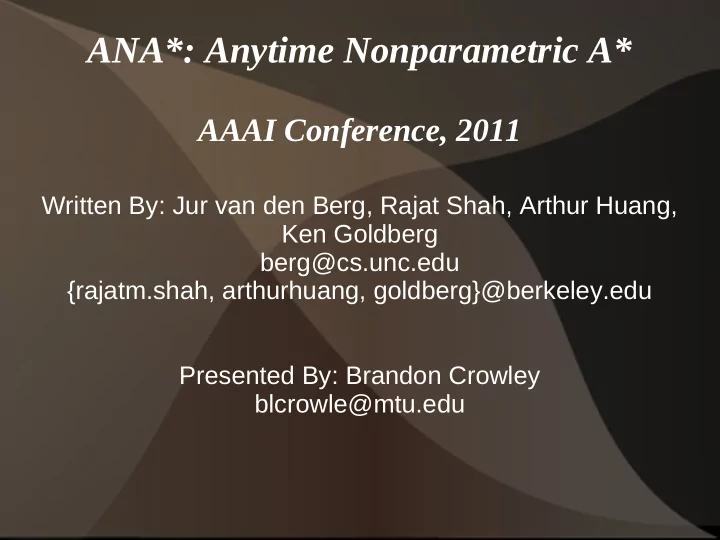

ANA*: Anytime Nonparametric A* AAAI Conference, 2011 Written By: Jur van den Berg, Rajat Shah, Arthur Huang, Ken Goldberg berg@cs.unc.edu {rajatm.shah, arthurhuang, goldberg}@berkeley.edu Presented By: Brandon Crowley blcrowle@mtu.edu
Outline ● Motivation ● Previous Work ● The Algorithm ● Improvements of ANA* Over ARA* ● Experimental Results ● Conclusion and Future Work
Previous Work: Foundations ● Dijkstra’s Algorithm ● Shortest path from s start to s goal with non-negative edges ● Maintains g(s), minimum cost so far ● A* ● Adds heuristic to Dijkstra’s ● Admissible h(s) guarantees optimality, consistent h(s) guarantees cycle-free search ● Weighted A* ● f(s) = g(s) + * h(s) ɛ ɛ > 1, bounds optimality ● ● Raising trades optimality for speed ɛ
Previous Work: Anytime A* ● Anytime Heuristic Search (AHS) ● Continues search after solution found ● Intermediate upper bound: G ● Intermediate lower bound: min s ∈ OPEN {g(s)+h(s)} ● Anytime Repairing A* (ARA*) ● Decreases between results, updating f(s) ɛ values ● Introduces another parameter ● Restarting Weighted A* (RWA*) ● Restarts search when is decreased ɛ ● Reuses best known g(s) values for states
The ANA* Algorithm ● IMPROVESOLUTION() ● ANA*() while OPEN ≠⌀ do G ←∞ ; E ←∞ ; OPEN ←⌀ ; s ← argmax s ∈ OPEN {e(s)} ∀ s:g(s) ←∞ ; g(s start ) ← 0 OPEN ← OPEN\{s} Insert s start into OPEN with key e(s start ) if e(s)<E then while OPEN ≠⌀ do E ← e(s) IMPROVESOLUTION() if ISGOAL(s) then Report current E-suboptimal G ← g(s) solution return Update keys e(s) in OPEN for each successor s’ of s do and prune if g(s)+h(s)>G if g(s)+c(s,s’)<g(s’) then g(s’) ← g(s)+c(s,s’) pred(s’) ← s if g(s’)+h(s’)<G then Insert or update s’ in OPEN with key e(s’)
The ANA* Algorithm cont. ● e(s) is the maximal for which f(s) ɛ <G ● e(s) bounds suboptimality ● G improves after each iteration e(s) = G-g(s) h(s)
ARA* vs ANA* ● Requires parameters and ● Requires no parameters ɛ ∆ ɛ ● Starting must be finite ɛ ● Starting G is infinite ● Progress towards optimal ● Progress towards optimal solution is invariable solution is the least possible ● If adapted to function like improvement at each step ANA*, f(s) keys would ● e(s) keys only need to be have to be updated for each updated when G is reduced change in ɛ
Experiments: Problems ● Robot Arm: position arm to reach goal, avoiding obstacles ● 6 or 20 degrees of freedom ● action is a change in a joint’s angle ● >3*10 6 states for 6 DOF, >10 26 states for 20 DOF ● Gridworld: navigate from start to goal in an n x m grid ● Grid 1: 100x1200 8-connected, obstacles, uniform move cost between cells sharing a side ● Grid 2: 5000x5000 4-connected, no obstacles, move cost randomly chosen from [1,1000] ● Grid 3: 5000x5000 4-connected, obstacles, move cost randomly chose from [1,1000]
Experiments: Problems cont. ● Multiple Sequence Alignment: find lowest cost alignments of n proteins ● n=5 ● gaps in a sequence cost 2 ● mismatched pairs cost 1
Experiments: Results-Robotic Arm 6 DOF vs 20 DOF
Experiments: Results-Robotic Arm 6 DOF, non-uniform cost
Experiments: Results-Gridworld 100x1200 with obstacles, uniform cost
Experiments: Results-Gridworld 5000x5000 without obstacles, random cost
Experiments: Results-MSA
Conclusion and Future Work ● ANA* expands upon ARA* ● ANA* outperforms existing anytime A* algorithms both analytically and experimentally ● Future research in dynamic weight graph search
Citations Jur van den Berg, Rajat Shah, Arthur Huang, and Ken Goldberg, “ANA*: ● Anytime Nonparametric A*, ” Association for the Advancement of Artificial Intelligence: Annual Conference (AAAI). San Francisco, CA. August 2011. Jur van den Berg, Rajat Shah, Arthur Huang, and Ken Goldberg, “ ANA* ● Technical Report,” February 2011. Maxim Likhachev, Geoff Gordon and Sebastian Thrun, "ARA*: Anytime ● A* with Provable Bounds on Sub-Optimality," Advances in Neural Information Processing Systems 16 (NIPS), MIT Press, Cambridge, MA, 2004.
Questions
Recommend
More recommend